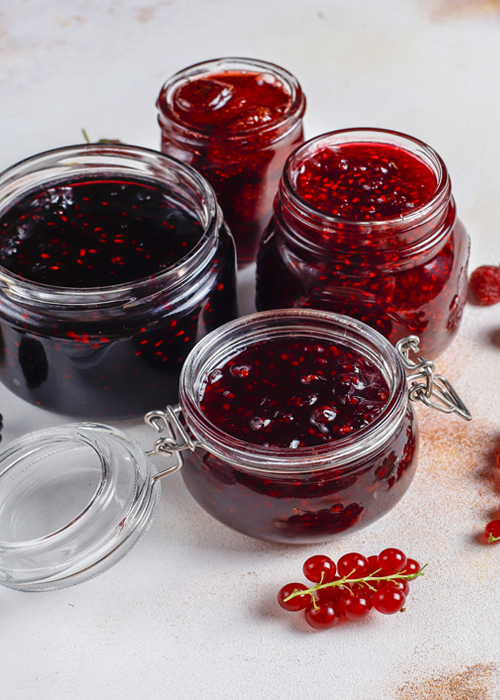BOTULISM
Botulism is a food borne intoxication caused by a toxin produced by the bacteria Clostridium Botulinum, more concretely by the consumption of the toxin produced by its spores. It is one of the most fatal illnesses we may contract at a feeding level since it may cause death, even with the right clinical treatment. The muscle and nerve paralysis that it produces, may affect the respiratory system and heart. Clostridium spores are resistant to high temperatures (212ºF for several hours) and they develop when exposed to low oxygen levels, so that the making of canned food requires certain cares we should not overlook. We should take special care when making low-acid or alkaline canned food from certain vegetables, seafood, fish and meat. (See FOOD PH section)
Making canned food using pressure cookers allow us to reach the suitable temperature for the bacterial spores destruction (Clostridium Botulinum ), 250ºF. for 20 min.
FOOD PH
The PH level of an ingredient or making shows if it is acid or alkaline food. There is a scale which calculates PH values between 0 and 14, considering 7 as neutral PH. Pure water is 7 PH. But if we refer to cooking terms, most food ranks are between 2 and 9. 2 PH belongs to acidic foods such as wine and alcohol vinegar or some citrus juices. Products with lower PH are not suitable for consumption, sulfuric acid 1PH, hydrochloric acid 0 PH. According to alkaline foods with higher PH, we have sodium bicarbonate which is 9 PH or yeast 8.4 PH. The PH level of tooth paste is 9.9, ammonia 11 and bleach 13.
In relation to the subject in question, the making of canned food, we consider a food to be acidic when the PH level is under 4.6, so alkaline foods will be those with a PH over 4.6. The reason of this scale is that with a 4.6 PH level or under, most bacteria and microorganisms are prevented from developing since they could contaminate our canned food.
Adding acids to reduce the PH of the makings until 4.6 is allowed with commercial canned delicate vegetables or foods that cannot be subjected to high temperatures, since Clostridium Botulinum is unable to prosper and produce botulinum toxin. Food PH does not have a constant value, it mainly depends on the season, ripening, coolness, etc. but, we may have some guide values.
Some food PH values:
Acidic PH values:
- Apples 3.4 / 3.9 Apricots 3.3 / 4.0 Lemon 2.2 / 2.4
- Lime 1.8 / 2.0 Blueberries 3.7 Tomato 4.2 / 4.9
Basic PH Values:
- Zucchini 5.8 / 6.2 Onion 5.3 / 5.8 Potato 6.1
- Peppers 4.6 / 4.9 Beans 5.7 / 6.3 Carrots 4.9 / 5.2
Taking these models as an example, we could think that if we make canned food with tomato sauce, which is 4.2 PH, we could be safe from the toxin, but we should take into account the rest of the ingredients added to the recipe, such as onion, carrot or peppers. These ingredients raise PH and we could reach the risk zone over 4.6.
COOKING TIMES AND TEMPERATURE CONTROL
You may find large homemade canned food recipes where double boiler is used with traditional pots to start canning. We may be told to maintain the cooking time for 45, 60 or 120 min, but with all that has been told until now we will see that this thermal treatment is only suitable for makings with a PH under 4.6.
Sterilization and pasteurization:
We may distinguish between 2 main thermal treatments for the making of canned food, Sterilization and pasteurization. Sterilization through application of high temperatures is defined as “the process by which all microorganisms life forms capable of producing food alteration in normal storage conditions, are destructed or inactive for a certain period of time”. Pasteurization “is the process of heating food to partially reduce pathogenic agents without changing its nutritional values, structural and gustatory qualities”.
The thermal treatment used and the cooking time of foods intended for canned food makings, mainly depends on three factors:
- Food making PH: With a PH under 4.5, we may use soft pasteurization treatments with the aim of not to alter its properties too much.
On the other hand, we should use sterilization procedures with foods whose PH is over 4.6.
- Water activity in food: food makings with high water activity level, over 0.86 require more intense thermal procedures, sterilization.
- The size of the can directly affects the required cooking time; the bigger it is, the more time it will take to reach the necessary temperature on the center of the can.
For canned food with a PH over 4.6, we should go to sterilization treatments with temperatures over 250ºF, for at least 20 min.
WATER ACTIVITY
Water activity, which should not be mixed up with the total humidity grade of food, is the quantity of water available in food which may be used by microorganisms and bacteria to live in, develop and multiply. This is a very interesting point when making canned food. Most food preservation methods are focused on reducing water availability, either because of evaporation, dehydration, liofilization, freezing or by adding sugar or salts. It is calculated with a scale from 0 to 1, having a water activity of 1. The rest of foods are between 0, 22 and 0.99 AW. The lower AW value of a food, the greater its preservation will be.
The water activity grade may also point out the type of microorganisms that will be more easily developed. For instance, bacteria need AW value over 0.86, while yeast and mold need lower activity, between 0.60 y 0.95.
Some water activity examples are:
- AW > 0, 95: Meat, fish, seafood, fresh vegetables, fruits, milk. They are easy to develop bacteria and pathogenic microorganisms which may even come to produce serious toxi-infections.
- AW > 0.90 < 0.95: Cheese and fresh cold cuts, evaporated milk or light salting. It is similar to the previous section; it is also a grade of favorable activity to the appearance of yeast and mold.
- AW> 0.87 < 0.90: Cheese and cured cold cuts, hams, condensed milk. Less pathogen bacteria activity but larger yeast and mold activity.
- AW > 0.71 < 0.86: Cold cuts and dried meats, bacon, cheese too much cured: it is practically impossible that bacteria develop, but there is still the possibility of contamination by yeast and mold.
- AW > 0.60 < 0.71: Nuts, marmalade: yeast and mold possible activity.
- AW < 0.60: Honey, chocolate, freeze-dried food, powdered milk, dried pasta, cookies, and candies. The microbial development stops.
GENERAL TIPS:
- The perfect size of containers for canning is between 250 ml. and 500 ml.
- We should leave a free space between the product and the lid so that it is correctly into space, between 1 cm and 1.5 cm. which is the recommended.
- When the packing is correct, the lid presents a concave curvature on the center.
- Once the canned food is made, label every can with the making date, ingredients, etc.
- Best before a year and keep in a dry place without abrupt temperature changes and protected from the light.
- Reject canned food with dented lids, do not even open them, the toxin could be transmitted through respiratory tracks. If industrial, they may be returned to the point of purchase.
- The presence of the botulinum toxin in canned food is not always accompanied by bad smells or flavors, it only happens when there is high concentration.
- When we apply the time given on the recipe, we should take into account the highness of our town. The higher it is, the more time we should apply.
- Between 300 and 1000 m + 5 minutes
- Between 1000 and 2000 m +10 minutes
- Between 2000 and 2700 m +15 minutes
- + 2700 m +20 minutes
- It may not be considered that canned foods with oil, only because of their value as a natural preservative and antioxidant, are free from bacterial contamination. After the manufacturing process, the internal liquid separates into two parts, the lower watery zone and the upper fat zone that will work as a blockage and produce a lower zone with little oxygen.
*Canned food in oil with a PH over 4.6 and subjected to a simple pasteurization, may develop toxins.


